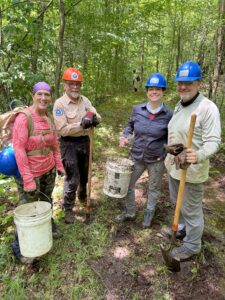Gillian Grant, a participant on the Boundary Waters Canoe Area Wilderness project we did with the LaCroix Ranger District in August, wrote a post for her employer’s blog about the experience. It finally went live this week and can be seen at this link with the title Wilderness Volunteers Enjoy Long Commute.
 |
| Sandy Stroo & Gillian Grant |
Gillian works at the University of North Texas and the piece was posted to the Community Engagement blog. It was edited (quite severely) from her original piece which is posted here:
Wilderness Volunteer trip to the Boundary Waters, August 2014
Imagine escaping that tedious crawl through repairs on Interstate-35 and replacing your commute with a quiet canoe ride on pristine, mirrored water floating by lily pads and wild rice with the sound of loons and only your paddle gently striking water. This was our typical 2 hour and 15 minute commute to work, and it was pure joy.
A couple of UNT IELI (Intensive English Language Institute) Faculty decided to spend some of their summer break getting closer to nature through the Wilderness Volunteers in a week long volunteer service trip to do some much-needed and much appreciated volunteer work for the forest service.
 |
| Gillian at work |
The daily commute was from our campsite on an island in Shell Lake in the Superior National Forest in the Boundary Waters Canoe Area that separates the USA from Canada in far NE Minnesota. The commute involved nearly an hour of hiking in a lush green forest where the Sioux- Hustler hiking trail traverses some dense, wonderful birch and pine trees. Part of the trail is on what seems to be a spongy bouncy tundra like springy carpet. This Texan was surprised to see the enormous number of trees felled by storms in various states of decomposition. Much of the area has glacially smoothed boulders a foot or two below the surface, so try as the trees do to anchor themselves, eventually the windstorms win and take down tall trees to expose horizontally massive root systems. Also on the daily commute was the wonderful peaceful, quiet canoe trip through lily pads, lotus, wild rice, and other marine based flora. The multiple portages which entailed carrying the canoe either by yourself over your shoulders or with your partner were a physical test, and the rocks in the water were a navigational challenge. Totally engaging and invigorating.
 |
| Sandy and Gillian at a portage |
Sandy Stroo (retired in August from IELI faculty at UNT after 18 years of service) and I were on a week long service trip doing trail maintenance on the Sioux –Hustler hiking trail with Wilderness Volunteers, a nonprofit outfit that was started by a couple of dedicated Sierra Club members 18 years ago who thought the Sierra Club volunteer trips had become too expensive. Wilderness Volunteers is based in Flagstaff, Arizona, and they run week long trips with 6-10 volunteer participants, in addition to 2 volunteer certified leaders, to clean up national and state parks and forest service land, choosing projects pitched to them by rangers all over the country. This year there were more than 60 trips. Sandy has done 3, and she inspired other IELI Faculty; I have done 5 trips, Donna Obenda did one and so did Sally Kloppe (currently on assignment for IELI and UNT teaching at Kansai Gaidai in Japan). In total, we IELI teachers have used time off in the summer (without pay) to participate in 10 WV trips in Colorado, Montana, California, Oregon, Alaska, Hawaii, and Minnesota. There is a small cost to participate ($300), which covers all food, beverages, and associated park costs. If selected for a trip, participants provide their own basic gear (tent, backpack, hiking boots, sleeping bag, thermarest, etc) and pay for their own transportation.
 |
| On the water |
On our trip to the Boundary Waters in August, there were 8 participants (including a mother-daughter leader team) and we worked with small tools called “silky saws” and a big old timey 2 person cross cut saw. Our team cut and cleared about 200 trees on the Sioux- Hustler hiking trail. It had been years since the trail had seen maintenance. Like most of our parks in America, they are vastly understaffed and depend on volunteer groups like the WV to keep trails open. In fact, there are 2 rangers assigned to maintain the trails in a half million acres at this park. As a consequence, ranger stations depend on volunteer groups like the WV to keep trails open.
If you like starry nights, frogs, loon cries, making new friends with people who love nature, and a great commute to work, you will love Wilderness Volunteers.
For more information, go to the WV website http://www.wildernessvolunteers.org/
– Gillian Grant


